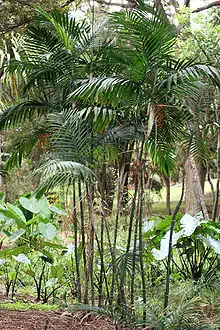| Chamaedorea | |
|---|---|
 | |
| Chamaedorea costaricana | |
| Scientific classification | |
| Kingdom: | Plantae |
| Clade: | Tracheophytes |
| Clade: | Angiosperms |
| Clade: | Monocots |
| Clade: | Commelinids |
| Order: | Arecales |
| Family: | Arecaceae |
| Subfamily: | Arecoideae |
| Tribe: | Chamaedoreeae |
| Genus: | Chamaedorea Willd.[1] |
| Species | |
|
See text | |
| Synonyms | |
|
Anothea O.F.Cook nom. inval. | |
Chamaedorea is a genus of 107 species of palms, native to subtropical and tropical regions of the Americas.[2][3] They are small palms, growing to 0.3–6 m (1 ft 0 in – 19 ft 8 in) tall with slender, cane-like stems, growing in the understory in rainforests, and often spreading by means of underground runners, forming clonal colonies. The leaves are pinnate (rarely entire), with one to numerous leaflets. The flowers are produced in inflorescences; they are dioecious, with male and female flowers on separate plants. The fruit is an orange or red drupe 0.5–2 cm diameter.[3] Perhaps the best-known species is Chamaedorea elegans (neanthe bella palm or parlor palm) from Mexico and Guatemala. It is popular as a houseplant, particularly in Victorian houses. Another well-known species is Chamaedorea seifrizii, the bamboo palm or reed palm.
The name Chamaedorea comes from Ancient Greek χαμαί (chamai) 'on the ground', and δωρεά (dorea) 'gift', in reference to easily reached fruits, or the plants' low-growing nature.[4]
Species
|
|
Formerly placed here
- Synechanthus fibrosus (H.Wendl.) H.Wendl. (as C. fibrosa H.Wendl.)[5]
See also
References
- 1 2 "Genus: Chamaedorea Willd". Germplasm Resources Information Network. United States Department of Agriculture. 2007-10-05. Archived from the original on 2010-05-29. Retrieved 2011-04-04.
- ↑ Royal Botanic Gardens, Kew, palms checklist: Chamaedorea
- 1 2 Huxley, A., ed. (1992). New RHS Dictionary of Gardening. Macmillan ISBN 0-333-47494-5.
- ↑ Quattrocchi, Umberto (2000). CRC World Dictionary of Plant Names. Vol. I A-C. CRC Press. p. 495. ISBN 978-0-8493-2675-2.
- ↑ "GRIN Species Records of Chamaedorea". Germplasm Resources Information Network. United States Department of Agriculture. Archived from the original on 2009-01-20. Retrieved 2011-04-04.
![]() Data related to Chamaedorea at Wikispecies
Data related to Chamaedorea at Wikispecies
